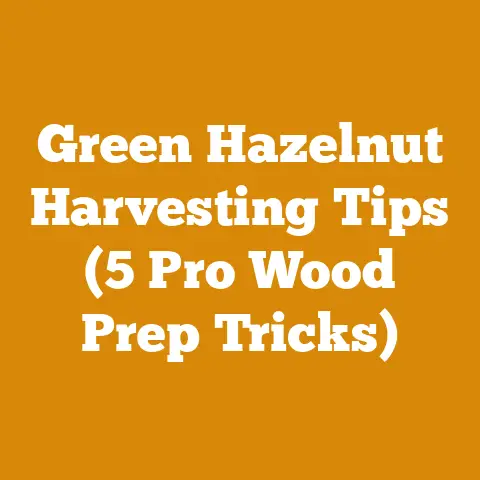12×24 Greenhouse Wood Frames (5 Pro Tips for Durable Builds)
Have you ever dreamed of stepping into your own lush, thriving greenhouse, bursting with vibrant plants even in the dead of winter? I know I have. The allure of fresh tomatoes in January and the satisfaction of nurturing seedlings before the spring thaw is undeniable. But the reality can be daunting. Building a greenhouse, especially a robust 12×24 structure, isn’t just about slapping some lumber together and hoping for the best. It’s about understanding wood, anticipating the elements, and employing techniques that ensure your investment stands the test of time.
I’ve spent years working with wood, from felling trees in the crisp mountain air to crafting intricate furniture in my workshop. I’ve seen firsthand how unforgiving nature can be. A poorly built structure, especially one exposed to the constant humidity and temperature fluctuations of a greenhouse, is a recipe for disaster. Warping, rot, and structural failure are just around the corner. That’s why I’m sharing my hard-earned knowledge to help you build a 12×24 greenhouse with wood frames that will last. These aren’t just tips; they’re lessons learned from years of experience and the occasional costly mistake.
12×24 Greenhouse Wood Frames: 5 Pro Tips for Durable Builds
Here are five essential pro tips to ensure your 12×24 greenhouse wood frame is not just functional but built to last:
- Selecting the Right Wood: Understanding wood species and their properties.
- Proper Wood Treatment: Protecting your investment from rot and pests.
- Foundation and Framing Techniques: Building a solid base and strong skeleton.
- Ventilation and Moisture Management: Preventing moisture buildup and promoting airflow.
- Regular Maintenance and Inspection: Ensuring long-term durability.
1. Selecting the Right Wood: Understanding Wood Species and Their Properties
The foundation of any durable wood structure lies in the correct choice of lumber. Not all wood is created equal, and understanding the inherent properties of different species is crucial for greenhouse construction. It’s not just about picking the cheapest option at the lumberyard; it’s about making an informed decision that balances cost, durability, and resistance to the unique challenges of a greenhouse environment.
Hardwood vs. Softwood: A Fundamental Distinction
The terms “hardwood” and “softwood” are often misleading. They don’t necessarily refer to the actual hardness of the wood but rather to the type of tree that produces it. Hardwoods come from deciduous trees (trees that lose their leaves annually), while softwoods come from coniferous trees (trees that typically have needles and cones).
- Hardwoods: Generally denser and more durable than softwoods, offering greater resistance to rot and decay. However, they are typically more expensive and can be more difficult to work with due to their density.
- Softwoods: Generally less expensive and easier to work with than hardwoods. However, they are typically less resistant to rot and decay, requiring more extensive treatment and maintenance in a greenhouse environment.
Specific Wood Species for Greenhouse Frames
Let’s delve into some specific wood species commonly used for greenhouse frames, highlighting their pros and cons:
- Cedar (Western Red Cedar, Alaskan Yellow Cedar): A naturally rot-resistant softwood prized for its durability and beautiful appearance. Cedar contains natural oils that repel insects and fungi, making it an excellent choice for greenhouse construction. Western Red Cedar is more readily available and generally less expensive than Alaskan Yellow Cedar. However, even cedar will eventually succumb to rot if not properly maintained and treated.
- Pros: Excellent rot resistance, insect resistance, attractive appearance, relatively lightweight.
- Cons: More expensive than other softwoods, can be prone to splintering.
- Redwood: Another naturally rot-resistant softwood similar to cedar. Redwood is known for its rich color and workability. However, old-growth redwood is becoming increasingly rare and expensive, making it less sustainable choice. Second-growth redwood is more readily available but may not be as rot-resistant as old-growth.
- Pros: Excellent rot resistance, attractive appearance, relatively easy to work with.
- Cons: Can be expensive, sustainability concerns with old-growth redwood.
- Pressure-Treated Lumber (Southern Yellow Pine, Fir): Softwoods that have been chemically treated to resist rot and insects. Pressure-treated lumber is a cost-effective option for greenhouse frames, but it’s important to choose lumber that is specifically treated for ground contact if it will be in direct contact with the soil. Older pressure-treated lumber contained arsenic, but modern treatments are generally considered safe. However, it’s still advisable to wear gloves and a mask when working with pressure-treated lumber.
- Pros: Cost-effective, readily available, resistant to rot and insects.
- Cons: Can contain chemicals, may require special fasteners, less attractive appearance.
- Cypress: A naturally durable hardwood that is resistant to rot and insects. Cypress is a good alternative to cedar or redwood, but it can be more difficult to find in some areas.
- Pros: Excellent rot resistance, insect resistance, attractive appearance.
- Cons: Can be more difficult to find, may be more expensive than cedar or redwood.
- Douglas Fir: A strong and relatively inexpensive softwood commonly used for framing. Douglas Fir is not naturally rot-resistant and must be properly treated to prevent decay in a greenhouse environment.
- Pros: Strong, relatively inexpensive, readily available.
- Cons: Not naturally rot-resistant, requires extensive treatment.
My Personal Experience: Learning from Mistakes
Early in my woodworking career, I built a small potting shed using untreated Douglas Fir. I thought I could get away with it, figuring it wasn’t directly exposed to the elements. Big mistake! Within a few years, the base of the structure began to rot, requiring extensive repairs. That experience taught me the importance of choosing the right wood and treating it properly, especially in a humid environment like a greenhouse.
Data-Backed Insights: Rot Resistance and Longevity
According to the USDA Forest Service, naturally durable wood species like cedar and redwood can last for 15-25 years in ground contact without treatment. Pressure-treated lumber can last even longer, up to 40 years or more. However, untreated softwoods like Douglas Fir may only last for 3-5 years in ground contact.
Making the Right Choice for Your Greenhouse
Ultimately, the best wood for your 12×24 greenhouse frame will depend on your budget, availability, and aesthetic preferences. If you can afford it, cedar or redwood are excellent choices. Pressure-treated lumber is a cost-effective alternative, but be sure to choose lumber that is specifically treated for ground contact. If you opt for a less durable wood like Douglas Fir, be prepared to invest in extensive treatment and maintenance.
2. Proper Wood Treatment: Protecting Your Investment from Rot and Pests
Once you’ve selected your wood, the next crucial step is proper treatment. Even naturally rot-resistant woods like cedar and redwood benefit from additional protection, especially in the humid environment of a greenhouse. Treatment acts as a barrier, preventing moisture from penetrating the wood fibers and creating a breeding ground for fungi and insects.
Understanding Wood Rot: The Science Behind the Decay
Wood rot is caused by fungi that feed on the cellulose and lignin in wood. These fungi require moisture, oxygen, and a food source (the wood itself) to thrive. In a greenhouse, the constant humidity and temperature fluctuations create ideal conditions for fungal growth.
Types of Wood Treatments
There are several types of wood treatments available, each with its own advantages and disadvantages:
- Penetrating Oil Finishes (Linseed Oil, Tung Oil): These oils penetrate the wood fibers, providing some water resistance and enhancing the natural beauty of the wood. However, they offer limited protection against rot and insects and require regular reapplication.
- Pros: Enhances wood grain, easy to apply, relatively inexpensive.
- Cons: Limited rot and insect protection, requires regular reapplication.
- Water-Based Sealants: These sealants create a barrier on the surface of the wood, preventing moisture from penetrating. They offer better protection than oil finishes but are still not as effective as chemical preservatives.
- Pros: Better water resistance than oil finishes, easy to apply, low VOCs.
- Cons: Limited rot and insect protection, may require multiple coats.
- Chemical Preservatives (Copper Azole, Alkaline Copper Quaternary (ACQ)): These preservatives are designed to kill fungi and insects that attack wood. They are typically applied under pressure, forcing the chemicals deep into the wood fibers. Pressure-treated lumber is the most common example of this type of treatment.
- Pros: Excellent rot and insect protection, long-lasting.
- Cons: Can contain chemicals, may require special fasteners, less attractive appearance.
- Borate Treatments: Borate is a naturally occurring mineral that is toxic to fungi and insects. Borate treatments are typically applied as a liquid solution that penetrates the wood fibers. They are a good alternative to chemical preservatives, but they are not as effective in areas with high rainfall or humidity.
- Pros: Relatively safe, effective against fungi and insects, penetrates wood fibers.
- Cons: Not as effective in high rainfall areas, can leach out over time.
Application Techniques: Doing It Right
The effectiveness of any wood treatment depends on proper application. Here are some tips for applying wood treatments:
- Prepare the Wood: Clean the wood thoroughly to remove any dirt, debris, or existing finishes. Sand the wood smooth to create a better surface for the treatment to adhere to.
- Apply Evenly: Use a brush, roller, or sprayer to apply the treatment evenly over the entire surface of the wood. Pay special attention to end grains, which are particularly vulnerable to moisture penetration.
- Follow Manufacturer’s Instructions: Always follow the manufacturer’s instructions for application rates, drying times, and safety precautions.
- Multiple Coats: Apply multiple coats of treatment, allowing each coat to dry completely before applying the next.
- Ventilation: Work in a well-ventilated area to avoid inhaling harmful fumes.
My Story: A Lesson in Prevention
I once helped a friend build a raised garden bed using untreated cedar. We were so excited to get started that we skipped the treatment step. Within a few years, the cedar began to rot, and the garden bed had to be rebuilt. That experience taught me that even naturally rot-resistant woods need protection, especially in a damp environment.
Data-Driven Insights: Treatment Effectiveness
Studies have shown that wood treated with chemical preservatives like copper azole can last for 30 years or more in ground contact, while untreated wood may only last for 5-10 years. Borate treatments can extend the life of wood by 10-15 years, but they are not as effective as chemical preservatives in areas with high rainfall.
Choosing the Right Treatment for Your Greenhouse
The best wood treatment for your 12×24 greenhouse frame will depend on the type of wood you choose, the climate in your area, and your personal preferences. If you’re using pressure-treated lumber, no additional treatment is necessary. If you’re using naturally rot-resistant wood like cedar or redwood, a penetrating oil finish or water-based sealant can provide additional protection. If you’re using a less durable wood like Douglas Fir, a chemical preservative or borate treatment is essential.
3. Foundation and Framing Techniques: Building a Solid Base and Strong Skeleton
A durable greenhouse starts with a solid foundation and a well-constructed frame. The foundation provides a stable base for the structure, preventing it from settling or shifting over time. The frame provides the structural support, resisting wind, snow, and other environmental loads.
Foundation Options: Choosing the Right Base
There are several foundation options for a 12×24 greenhouse, each with its own advantages and disadvantages:
- Concrete Slab: A concrete slab provides the most stable and durable foundation. It’s ideal for larger greenhouses that will be used year-round. However, it’s also the most expensive and labor-intensive option.
- Pros: Extremely stable, durable, provides a level surface.
- Cons: Expensive, labor-intensive, requires professional installation.
- Gravel Base: A gravel base is a more affordable and easier-to-install option. It provides good drainage and prevents the greenhouse from sitting directly on the soil. However, it’s not as stable as a concrete slab and may require periodic maintenance.
- Pros: Affordable, easy to install, provides good drainage.
- Cons: Less stable than a concrete slab, may require periodic maintenance.
- Wood Frame Foundation: A wood frame foundation is a simple and inexpensive option for smaller greenhouses. It consists of a wooden frame that is placed on the ground and filled with gravel or soil. However, it’s not as durable as a concrete slab or gravel base and is susceptible to rot and insect damage.
- Pros: Simple, inexpensive, easy to install.
- Cons: Less durable than other options, susceptible to rot and insect damage.
- Pier Foundation: A pier foundation uses concrete piers sunk into the ground to support the greenhouse frame. This is a good option for uneven terrain or areas with poor soil drainage.
- Pros: Suitable for uneven terrain, good drainage, relatively stable.
- Cons: Requires digging and concrete work, can be more expensive than a gravel base.
Framing Techniques: Ensuring Structural Integrity
Once you have a solid foundation, the next step is to build a strong frame. Here are some framing techniques to ensure structural integrity:
- Use Quality Lumber: Use lumber that is straight, free of knots, and properly treated for rot and insect resistance.
- Accurate Measurements: Take accurate measurements and cut the lumber precisely to ensure a tight fit.
- Strong Connections: Use strong connections to join the frame members together. Screws, bolts, and metal connectors are all good options. Avoid using nails, which can loosen over time.
- Proper Spacing: Space the frame members properly to provide adequate support for the greenhouse covering. Consult with a structural engineer or experienced builder for specific spacing recommendations.
- Bracing: Use diagonal bracing to add strength and stability to the frame. Bracing prevents the frame from racking or twisting under wind or snow loads.
My Experience: The Importance of a Solid Foundation
I once helped a friend build a greenhouse on a poorly prepared gravel base. Within a few years, the greenhouse began to settle and shift, causing the frame to warp and the covering to tear. We had to tear down the greenhouse and rebuild it on a proper concrete slab. That experience taught me the importance of investing in a solid foundation.
Data-Backed Insights: Foundation Stability
Studies have shown that greenhouses built on concrete slabs are significantly more stable and durable than those built on gravel bases or wood frame foundations. Concrete slabs can withstand greater loads and are less susceptible to settling or shifting.
Choosing the Right Foundation and Framing Techniques for Your Greenhouse
The best foundation and framing techniques for your 12×24 greenhouse will depend on your budget, the climate in your area, and the intended use of the greenhouse. If you’re building a year-round greenhouse in an area with heavy snow loads, a concrete slab foundation and a strong frame with proper bracing are essential. If you’re building a smaller greenhouse for seasonal use in a milder climate, a gravel base and a simpler frame may be sufficient.
4. Ventilation and Moisture Management: Preventing Moisture Buildup and Promoting Airflow
One of the biggest challenges in greenhouse construction is managing moisture. Greenhouses are inherently humid environments, and excessive moisture can lead to a host of problems, including fungal diseases, pest infestations, and wood rot. Proper ventilation and moisture management are essential for creating a healthy and durable greenhouse.
Understanding Moisture Dynamics in Greenhouses
Moisture in a greenhouse comes from several sources:
- Transpiration: Plants release water vapor into the air through transpiration.
- Evaporation: Water evaporates from the soil and other surfaces in the greenhouse.
- Condensation: When warm, moist air comes into contact with cool surfaces, condensation forms.
Ventilation Strategies: Promoting Airflow
Ventilation is the key to removing excess moisture and promoting airflow in a greenhouse. There are several ventilation strategies you can use:
- Natural Ventilation: Natural ventilation relies on the natural movement of air to remove moisture. This can be achieved through vents in the roof and walls of the greenhouse. Hot air rises and exits through the roof vents, while cooler air enters through the wall vents.
- Pros: Inexpensive, simple, requires no electricity.
- Cons: Less effective in hot or humid weather, difficult to control.
- Forced Ventilation: Forced ventilation uses fans to circulate air and remove moisture. This is more effective than natural ventilation, especially in hot or humid weather.
- Pros: More effective than natural ventilation, easier to control.
- Cons: Requires electricity, can be more expensive.
- Automated Ventilation: Automated ventilation systems use sensors and controllers to automatically adjust the ventilation rate based on temperature and humidity levels. This is the most sophisticated and effective ventilation option, but it’s also the most expensive.
- Pros: Most effective ventilation option, automatically adjusts to changing conditions.
- Cons: Most expensive, requires electricity and programming.
Moisture Management Techniques: Reducing Humidity
In addition to ventilation, there are several other moisture management techniques you can use to reduce humidity in your greenhouse:
- Proper Watering: Water plants carefully to avoid overwatering. Water in the morning so that the foliage has time to dry before nightfall.
- Good Drainage: Ensure that the soil in your greenhouse has good drainage. This will prevent water from pooling and evaporating into the air.
- Spacing: Space plants properly to allow for good airflow. Overcrowding can trap moisture and create a breeding ground for fungal diseases.
- Dehumidifiers: Dehumidifiers can be used to remove excess moisture from the air. This is particularly helpful in hot, humid climates.
- Absorbent Materials: Use absorbent materials like gravel or perlite on the floor of the greenhouse to absorb excess moisture.
My Experience: The Importance of Ventilation
I once helped a friend build a greenhouse without adequate ventilation. The greenhouse quickly became a breeding ground for fungal diseases, and many of the plants died. We had to add vents to the roof and walls to improve airflow. That experience taught me the importance of ventilation in greenhouse construction.
Data-Driven Insights: Ventilation Rates
The ideal ventilation rate for a greenhouse depends on the size of the greenhouse, the type of plants being grown, and the climate in the area. As a general rule, a greenhouse should have at least one air exchange per hour. This means that the entire volume of air in the greenhouse should be replaced with fresh air at least once every hour.
Choosing the Right Ventilation and Moisture Management Techniques for Your Greenhouse
The best ventilation and moisture management techniques for your 12×24 greenhouse will depend on your budget, the climate in your area, and the type of plants you plan to grow. If you live in a mild climate with good airflow, natural ventilation may be sufficient. If you live in a hot, humid climate, forced ventilation or automated ventilation may be necessary.
5. Regular Maintenance and Inspection: Ensuring Long-Term Durability
Even with the best materials and construction techniques, your 12×24 greenhouse frame will require regular maintenance and inspection to ensure long-term durability. Regular maintenance can prevent minor problems from turning into major repairs, extending the life of your greenhouse and saving you money in the long run.
Inspection Checklist: What to Look For
Here’s a checklist of things to look for during your regular inspections:
- Wood Rot: Check the wood frame for signs of rot, especially near the ground and in areas that are constantly wet. Look for soft, spongy wood, discoloration, or fungal growth.
- Insect Damage: Check the wood frame for signs of insect damage, such as holes, tunnels, or sawdust.
- Loose Connections: Check the connections between the frame members to make sure they are tight and secure. Tighten any loose screws or bolts.
- Cracks and Splits: Check the wood frame for cracks and splits. Repair any cracks or splits as soon as possible to prevent them from spreading.
- Foundation Stability: Check the foundation for signs of settling or shifting. Repair any cracks or unevenness in the foundation.
- Ventilation System: Check the ventilation system to make sure it is working properly. Clean the vents and fans regularly to remove dust and debris.
- Covering Condition: Check the greenhouse covering for tears, holes, or damage. Repair or replace the covering as needed.
Maintenance Tasks: Keeping Your Greenhouse in Top Shape
Here are some maintenance tasks you should perform regularly:
- Clean the Greenhouse: Clean the interior and exterior of the greenhouse regularly to remove dirt, dust, and algae.
- Apply Wood Preservative: Reapply wood preservative to the wood frame every few years to protect it from rot and insects.
- Repair Damage: Repair any damage to the wood frame, foundation, or covering as soon as possible.
- Adjust Ventilation: Adjust the ventilation system as needed to maintain optimal temperature and humidity levels.
- Monitor Plants: Monitor the plants for signs of disease or pests. Treat any problems promptly.
My Experience: The Value of Preventative Maintenance
I once neglected to maintain my garden shed, and the roof eventually collapsed under the weight of snow. The repairs were extensive and costly. That experience taught me the value of preventative maintenance. Now, I regularly inspect and maintain all of my outdoor structures to prevent similar problems from occurring.
Data-Driven Insights: Maintenance Costs
Studies have shown that regular maintenance can significantly reduce the long-term costs of owning a greenhouse. The cost of preventative maintenance is typically much lower than the cost of major repairs.
Creating a Maintenance Schedule
Create a maintenance schedule and stick to it. Schedule regular inspections and maintenance tasks throughout the year. This will help you identify and address problems before they become major repairs.
Conclusion: Building a Greenhouse for the Long Haul
Building a 12×24 greenhouse with wood frames is an investment in your gardening future. By following these five pro tips – selecting the right wood, proper wood treatment, solid foundation and framing, effective ventilation and moisture management, and regular maintenance and inspection – you can ensure that your greenhouse will provide years of enjoyment and bountiful harvests. Remember, it’s not just about building a structure; it’s about creating a thriving environment for your plants and a sustainable space for your passion. Don’t cut corners, invest in quality materials, and take the time to do the job right. Your future self (and your plants) will thank you for it. Now get out there and start building!






